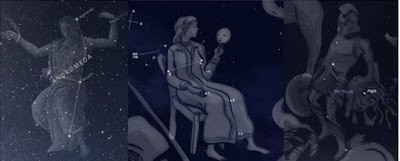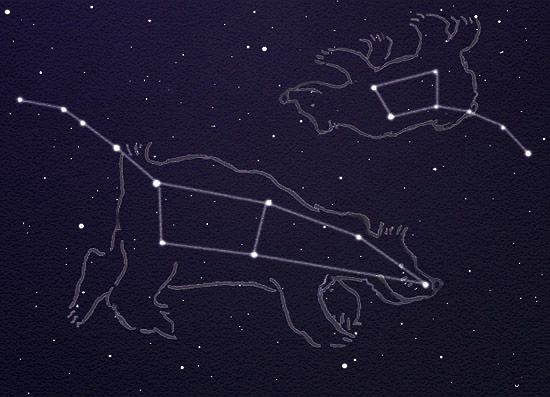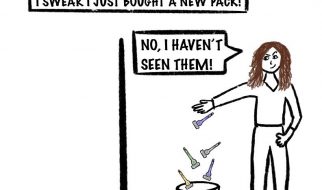Mythologies behind constellations
For years, humans have been inexplicably drawn to the mystery and beauty of the stars. This fascination has manifested deeply in our culture. It can even be seen in children songs to ?starry night? and other works of art. The night sky is an inexhaustible source of knowledge that can be used to understand not only outer-space, but the working of our planet.

Our ancestors knew the night sky like the back of their hands. They observed them until they found patterns in the stars and utilized them as tools for navigation. They embedded the fabric of their beliefs and culture into the sky by projecting their heroes and symbols onto stars and made the very first constellations. It was the Greek philosopher, Ptolemy in the 2nd century, who first identified and listed 48 constellations. His notes were used for centuries and set a benchmark in astronomy.
Today, there are 88 officially recognized constellations in the sky. With apps like Google Sky and Astroviewer, it has become increasingly easy to locate these constellations. But, knowing the intricate stories behind these constellations can be both satisfying and humbling experience.
I discovered the inadequacy of my knowledge of constellations when I attended a stargazing event hosted by Nakshatra at NITT. To remedy this, I?ve compiled a list of my favorite constellations and have included the mythology behind them.
Andromeda, Perseus, & Cassiopeia

The King Cepheus and Queen Cassiopeia of Ethiopia had a beautiful daughter named Andromeda. The vain Queen Cassiopeia whose boastfulness knew no bounds, claimed that her daughter was more beautiful than even the sea nymphs. Upon hearing of this, the sea god, Poseidon threatened to unleash a flood and monster to Ethiopia. In order to save the kingdom, Andromeda was sacrificed and chained to a sea-cliff to be devoured by the monster.
Perseus who was sailing by was captivated by the frail beauty. In return for her parents permission to marry Andromeda, Perseus killed the beast and joyously claims his bride.
Athena placed Andromeda in the skies next to Perseus. Poseidon also placed Cassiopeia in the heavens on her throne, where she hangs upside down half the year as punishment for her sins.
Orion & Scorpius
The King Orion was the son of the poor shepard called Hyrieus. Once, the gods Zeus, Hermes, and Poseidon stopped by Hyrieus? house. Hyrieus was unaware that his guests were gods but, was so generous with his guests that he killed the only animal he had, an ox, to feed them.

The gods rewarded Hyrieus? generosity by granting him a wish. Hyrieus desired a child. The gods told him to bury the hide of the bull he had sacrificed for them and that after nine months, a boy will be born.
The child grew into a very handsome and strong man. He was such a good hunter that he was hired by the king Oenopion to kill the ferocious beasts that were terrifying the inhabitants of the island Chios. Orion promised to kill all the wild animals on the earth. But. the earth goddess Gaia, the mother of all animals, was not pleased with Orion.

To retaliate, Gaia set an enormous scorpion on Orion. Orion soon realized that his strength and sword were useless against the mighty beast. He tried to escape, but the scorpion stung him to death. As a reward, Gaia placed the scorpion in the sky as a constellation which appears to be constantly chasing after Orion whose figure was also placed among the stars.
Orion is usually easy to find because his belt, consisting of three stars, is very bright.
Ursa Major & Ursa Minor

Zeus was smitten for a young nymph named Calisto. Hera, Zeus?s wife, was jealous, and transformed Calisto into a bear.
In animal form, Calisto encountered her son Arcas. As she raised her arms, to embrace him, Arcas feared that the bear was trying to attack him. Being the man that he was, he was inclined to shoot the bear. In order to prevent this, Zeus turned Arcas into a bear as well, and grabbed the bears by their tails and flung them into the safety of the sky. The mother (Ursa Major) can be seen along with her son (Ursa Minor) permanently in the night sky.
This constellation is relatively easy to find. It includes the well known little and big dipper. The Ursa Minor includes Polaris, the north star and the end of the bear?s tail.
Corona Borealis ? The Northern Crown
Minos, the second king of Crete, had a great labyrinth built to confine the ferocious Minotaur. The maze was so complex and confusing that even the designer, Daedalis, was almost unable to find his way back to the entrance. Each year, King Minos exacted, as part of his tribute from Athens, twelve of the most handsome or beautiful young people to be placed in the labyrinth as food for the monster.

In the third group to be selected was Theseus, King of Athens. Minos? daughter Ariadne, fell in love with Theseus and offered to help him if he would take her away with him when he escaped. He agreed. She gave him a ball of magical thread to unwind while he was in the labyrinth so that when he killed the Minotaur he could follow the thread and find his way out again.
Theseus attacked and killed the terrible monster and then followed the magical thread and was able to find his way out of the labyrinth. Theseus sailed away from Crete taking Ariadne with him and went to the island of Naxos where he deserted Ariadne and sailed to his home.
Ariadne had nowhere to go and was extremely sad when Dionysus, the god of wine and parties, came to her aid. Dionysus fell in love with the beautiful Ariadne and treated her with great tenderness. He had a crown made for her with one each of the seven most beautiful jewels to be found mounted in it. When Ariadne died, Zeus placed her crown in the sky and changed the jewels to seven stars, which can still be seen today as the constellation Corona Borealis, Ariadne?s Crown.

